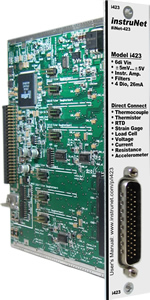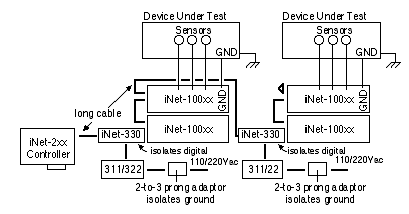MAXIMIZING STRAIN GAGE & LOAD CELL ACCURACY
The following instruNet hardware supports Strain Gage Measurements (i.e. measures μStrain of bending or twisting material).
Overview Hardware Setup Since we are working with the i100 (not with the i420/i430/i60x 12), we added two 0.1uF capacitors to create a 4KHz low pass filter [Fc = 4000Hz = 1/(6.28 * R * C) = 1/(6.28 * 350ohms * .1e-6Farads)] to attenuate RFI energy that couples into the system. Without this filter, RFI energy can easily add several hundred µStrain of offset errors and noise. These capacitors, close to the instruNet terminals, are necessary in order to achieve microVolt accuracy's with a long gage cable (e.g. > 3meters) with the i100. These capacitors are NOT recommended with the i420/i430/i60x 12. The bridge completion resistors are 350ohm 1/4Watt devices with a 0.1% initial accuracy and 5ppm/C temperature coefficient.
Strain Gage Wiring Guidelines
Software Setup
The above settings show a voltage range of ±80mV yet in many cases, a smaller voltage range such as ±10mV is adequate. If you increase the amount of strain on your gage and bump into a maximum returned value, then consider increasing the voltage range (e.g. move from ±10mV to ±20mV ) . i100 Low Pass Filters
Grounds and Power Supply Wiring
Balancing the Bridge Strain Vs. microStrain Verifying that RFI is not inducing Noise or an Offset Error To simulate an electrically hostile environment, move the gage cable into a computer and wrap it around a video board. This can be done while the gage is at 0 µStrain, or when it is connected to R_shunt. Any loop of wire in the voltage measurement path (i.e. from Vin+, to the gage, and back to Vin-) is a directional antenna. RFI energy that passes through the loop induces a voltage, which can then be seen as an offset or as noise. Moving the cables around changes the RFI fields that enter the loop, and therefore changes what is viewed on the computer. The two capacitors close to the instruNet screw terminals attenuate most of this effect. Without these capacitors on the i100 (not with the i420/i430/i60x 12), one can typically see hundreds of µStrain of effect from moving the cables, even with only a 10cm diameter loop of exposed wire. Notice that loops are most prevalent at the gage, and at the bridge completion resistors; therefore, careful wiring at these positions, as noted earlier, is important. Verifying that the Measured Value is Correct
delta_Rgage = Rgage * strain * GF An Analysis of Measurement Errors There are 4 sources of Temperature Drift (errors caused by a change in temperature): 1a. Ro Temperature Drift 1b. Rgage Temperature Drift 1c. instruNet Temperature Drift 1d. Material being measured Temperature Drift There are several sources of General Measurement errors: 2a. Rshunt Verification Resistor Accuracy 2b. instruNet Voltage Measurement Error 2c. Strain Gage Errors There are several sources of Noise errors: 3a. instruNet Measurement Noise 3b. Noise from RFI The best way to kill RFI with the i100 (not with the i420/i430/i60x 12) is to place capacitors at the instruNet input terminals. The capacitor lets low frequencies pass, and stops high frequencies. For information on low pass filters and capacitors, please see Low Pass Filters. For information on how to diagnose and fix an RFI problem, please see Verifying that RFI is not inducing noise or an offset. In summaryk, two 0.1uF capacitors are strongly recommended with the i100 if the signal you are measuring is <1KHz and the measured reading is not accurate or moves when instruNet-to-gage cables are moved. 3c. Noise from AC Power Lines 3d. High Frequecies between grounds Maximizing microVolt per microStrain ratio The number of uV per unit of μStrain with a ¼ Bridge in Bending configuration is summarized as uV/µStrain = Vexcitation * GF / 4. For example, 5Volts of excitation and a GF of 2 correspond to 2.4uV per µStrain. Below are several ¼ Bridge Bending configurations:
Summary |






